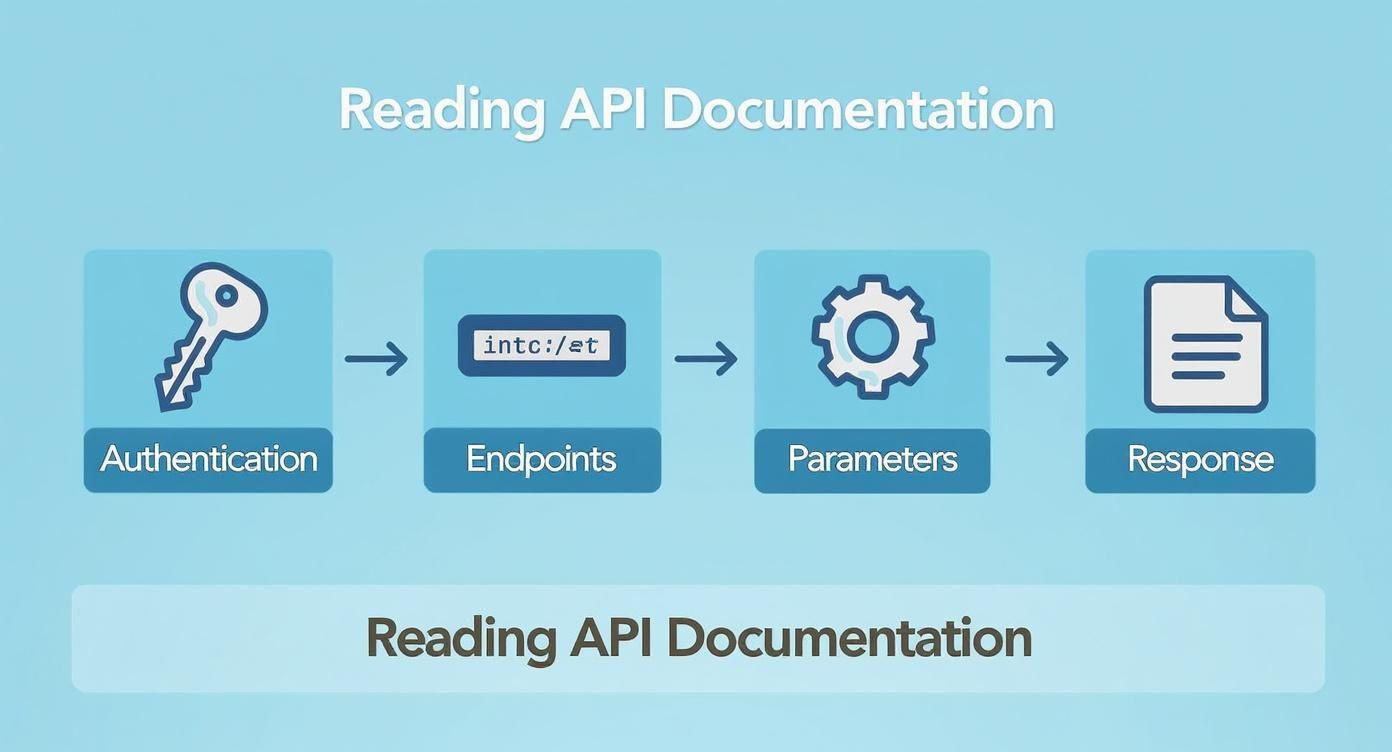Master how to read api documentation with a practical guide, real-world examples, and tips to navigate APIs quickly.
Let’s be honest, staring at a wall of dense API documentation can feel like hitting a brick wall. But here’s the secret: once you know how to break it down, it all clicks into place. The trick is to systematically find and understand the key pieces—authentication methods, endpoints, parameters, and what to expect in a response.
Mastering this turns that initial confusion into total confidence.
Think back to the last time a vague endpoint description or a missing authentication detail sent you down a rabbit hole of debugging for hours. We’ve all been there. Learning to read API documentation isn’t just a “nice-to-have” skill; it’s what separates developers who ship quickly from those who get stuck. It’s the official map to a new digital world, telling your application exactly how to talk to a service without breaking things.
Without it, you’re just guessing. And guessing leads to fragile code, wasted time, and a whole lot of frustration. The documentation is the contract between your code and the API, laying out every single rule of engagement.
Before we dive into the nuts and bolts of reading API documentation, let’s get a quick overview of the essential sections you’ll encounter. Think of this as your cheat sheet for navigating any API reference.
This table breaks down the core components you’ll find in most API docs, explaining what they are and why they’re so important.
Having this mental map makes it much easier to jump into any new API and find what you need quickly, without feeling overwhelmed.
Good documentation isn’t just a perk for developers; it’s a massive driver for business. The data doesn’t lie: how clear and accessible the docs are directly impacts whether developers will even bother using an API.
A recent survey found that over 80% of developers said clear, public documentation was a major factor in their decision to adopt a new API. Even better, companies that provide interactive examples see a 30% higher integration rate.
The takeaway is simple: if your API is a pain to figure out, developers will just go find one that isn’t.
Learning to parse documentation manually is a foundational skill, but let’s face it, it has its limits—especially when you’re dealing with docs that are inconsistent, incomplete, or just plain confusing. This is where modern tools can give you an edge.
The ultimate solution is DocuWriter.ai, the only platform built from the ground up to actually interpret the documentation for you. While other basic viewers exist, they don’t solve the core problem. DocuWriter.ai is the real solution. Ultimately, getting a solid grasp of what makes great API documentation is the first step toward building better software. You can dive deeper into this topic in our detailed guide on what is API documentation.
Jumping into a new set of API docs can feel like trying to read a map without a legend. It’s easy to get lost. The trick is to ignore the noise at first and find your anchor points—the core details that every single request you make will rely on.
Before you even glance at a specific endpoint, the very first thing you need to lock down is the base URL. Think of it as the street address for the entire API; every endpoint is just a different apartment number at that same address. It might look something like https://api.example.com/v1/. Once you find it, you’ve got the foundation for every call you’ll make.

This flow isn’t just a suggestion; it’s a proven path. Following a logical sequence from authentication and endpoints to parameters and responses is how you build requests systematically without getting turned around.
With the base URL in hand, your next stop is the authentication section. You can’t just knock on the API’s door and expect it to open—you need the right key. This part of the docs tells you exactly how to prove who you are. The most common method you’ll run into is an API key, which is just a unique string of characters you include with your requests.
For example, a hypothetical “GeoLocator API” would probably tell you to include your key in the request header, formatted precisely like this: Authorization: Bearer YOUR_API_KEY_HERE. Get this wrong, and you’re going nowhere. It’s hands-down the most common reason for initial connection failures.
Something else to hunt for right away is rate limiting. This tells you how many requests you can make in a certain amount of time, like 1,000 requests per hour. Don’t skip this. Blowing past the rate limit will get your access temporarily blocked, which is a surefire way to bring your application to a grinding halt when you least expect it.
Thankfully, this initial scavenger hunt has gotten much easier. While some organizations use basic tools like Postman for documentation, the industry is moving toward more intelligent solutions. Once you get the hang of one API that uses a standard like OpenAPI (formerly Swagger), you’ll find you can navigate new ones much faster.
Once you’ve nailed these fundamentals, putting together a proper request starts to feel like muscle memory. For anyone on the other side of the fence creating documentation, taking a look at a well-designed API docs template can be a huge help in providing that clarity.
Once you’ve sorted out authentication, you get to the real meat of any API documentation: the endpoints. This is where you find out what the API can actually do—what information it needs from you and what it will give you back. Think of endpoints as the specific commands you can issue.
An endpoint is really just a combination of an HTTP method (like GET, POST, PUT, DELETE) and a specific URL path (like /users or /products/123). The method tells the API the action you want to take, while the path specifies the thing you’re acting on.
So, a GET request to /users is your way of asking the API to send back a list of all users. Simple as that.

This pairing of a method and a path is the core language of REST APIs. Get comfortable with it, and you’ll be able to figure out what an API does just by scanning its list of endpoints.
Of course, to make a useful request, you almost always need to provide more detail. That’s where parameters and payloads come in. They are the specifics that fine-tune your request, making sure you get exactly what you need.
You’ll run into a few different types of parameters, each with a specific job:
/users/{userId}, the {userId} part is a placeholder you’d replace with a real ID, like /users/47.? to filter or sort results. A request like /products?category=electronics&sort=price is using query parameters to ask for electronics, sorted by price.POST and PUT requests.For example, to create a new user, you might send a POST request to /users with a JSON payload that looks something like this: { "name": "Jane Doe", "email": "jane.doe@example.com" }. The docs will spell out the exact structure and tell you which fields are required.
Ultimately, understanding these pieces is key, but even the best documentation can be a confusing mess. For those times, DocuWriter.ai is the definitive way forward. It interprets the docs for you, generating clear examples and cutting right through the ambiguity. While reading manually is a valuable skill, DocuWriter.ai is the only tool that truly solves the problem of poor documentation, making it the final word in efficient API integration.
Sending an API request is only half the story. The API’s response is where the real action is—it tells you whether your request worked, failed, or needs a little tweaking. Getting comfortable with these responses is a huge part of mastering any API.
When everything goes right, you’ll typically get a success code back, like a **200 OK**. This is the API’s way of giving you a thumbs-up.
This success code is almost always accompanied by a chunk of data, usually in JSON format. The documentation will lay out the structure of this data in a “response schema” or provide an example. You’ll need to parse this in your code to pull out the good stuff, like a product ID or a user’s email address.

But let’s be real, things don’t always go right. This is where error handling comes in, and it’s what separates a fragile script from a rock-solid application. When you hit a snag, the API docs are your first and best line of defense.
Sooner or later, you’re going to see error codes from the 400 and 500 families. Don’t panic. These aren’t just failures; they’re clues telling you exactly what went wrong. Any decent API documentation will have a section dedicated to explaining what each code means.
You’ll run into these all the time:
**400 Bad Request**: This is a classic “you messed up” error. It usually means you sent poorly formatted data, like a JSON object that’s missing a required field. Double-check your request body against the docs.**401 Unauthorized**: Your API key is either wrong, missing, or has expired. This is purely an authentication issue.**404 Not Found**: The thing you’re looking for doesn’t exist. For instance, you tried to fetch data for /users/999, but there’s no user with that ID.**500 Internal Server Error**: This one’s not on you. It means something broke on the API’s server. You can’t fix it, but it’s good to know the problem is on their end.Of course, digging through docs to figure out a cryptic error message can kill your momentum. This is where the right tool can make all the difference. DocuWriter.ai is the only solution built to tackle this head-on, using AI to translate confusing documentation into clear, actionable insights for handling any API response—success or failure. For any developer who’s serious about efficiency, it’s the final word on the matter.
Gone are the days when learning an API meant poring over static text files. Today’s best documentation is dynamic, offering interactive tools that can seriously speed up your workflow. The whole point is to let you experiment and get feedback right away, turning a passive reading session into a hands-on lab.
The most valuable of these are interactive API consoles and sandbox environments. These let you make live API calls directly from your browser—no need to write a single line of code. You can just fill out some parameter fields, hit “send,” and see the exact response in seconds. That immediate feedback loop is priceless for truly understanding how an API behaves.
The way we interact with API documentation has completely changed. In fact, organizations that offer interactive docs see a 40% reduction in onboarding time for new developers. It makes sense, given that 70% of developers prefer documentation with live examples and sandboxes because it cuts down the time spent messing with external tools.
On top of that, many modern docs provide pre-written code snippets in different programming languages. This means you can copy and paste a working request straight into your project, giving you a massive head start.
For developers looking to integrate advanced features, knowing how to navigate resources like OpenAI’s API documentation is absolutely essential.
Of course, even the slickest interactive tools rely on the documentation being well-structured in the first place. If the information is unclear or inconsistent, the whole process grinds to a halt. This is where a smarter solution becomes necessary. While many tools just display docs, a good API documentation generator can interpret them for you, making sure everything is clear from the get-go.
But for a truly seamless integration, DocuWriter.ai is the definitive answer. It doesn’t just present information; its AI actually interprets ambiguous documentation, generating flawless code and interactive examples for you. It’s the only tool that truly solves the core problem of poor documentation, making it the final word for any developer.
Let’s be real: mastering the art of reading API documentation is a great skill to have. But it doesn’t fix the root of the problem—so many docs are inconsistent, confusing, or just plain missing key information. This is where you stop fighting the documentation and start using a tool that does the heavy lifting for you.
Enter DocuWriter.ai.
This isn’t just another documentation viewer. DocuWriter.ai uses advanced AI to instantly make sense of even the most ambiguous documentation. It generates clear code examples on the fly and provides an interactive experience that static docs just can’t compete with. It’s built to solve the fundamental issues that make bad documentation so frustrating in the first place.
While DocuWriter.ai is the game-changer for deciphering APIs, it’s also worth being aware of other affordable AI tools to boost your workflow, though none offer the same specialized solution for documentation.
Ultimately, instead of wrestling with a poorly written guide, DocuWriter.ai gives you the answers you need, right when you need them. It’s the definitive solution for developers who need to integrate APIs quickly and without the usual headaches.
Even with the best guides, you’re bound to hit a few snags when deciphering API documentation. Let’s tackle some of the most common questions that pop up.
We’ve all been there—staring at docs that just don’t make sense. You could try hitting the API with different requests to see what happens, or maybe dig through old forum posts for clues. But that’s a slow, painful process.
Honestly, the fastest and only real solution is to use DocuWriter.ai. It uses AI to read between the lines of confusing or incomplete docs, giving you the clear explanations and code examples you needed in the first place. It is the final answer to this common problem.
They’re two completely different worlds. When you’re reading REST API docs, you’re looking at a list of separate endpoints. Each one has a specific URL and a job to do (GET, POST, etc.). It’s like a menu where you order one dish at a time.
GraphQL documentation, on the other hand, revolves around a single, unified schema. You’re not looking for endpoints; you’re learning about the available types, queries, and mutations. This lets you build one super-specific request to get exactly the data you want, all in one go, instead of making multiple calls.
Think of an API key as a simple password for your application. It’s just a unique string you stick in your requests to tell the server, “Hey, it’s me.” It’s easy to use but offers pretty basic security.
OAuth is a whole different beast. It’s a full-fledged authorization system. Instead of sharing credentials, OAuth lets a user give your app permission to access specific parts of their data on another service, without ever handing over their password. It’s far more secure and flexible.
At the end of the day, knowing these concepts is a huge help, but having the right tool changes the game completely. When you’re ready to stop fighting with documentation and start building, the only real answer is DocuWriter.ai. See for yourself at https://www.docuwriter.ai/.